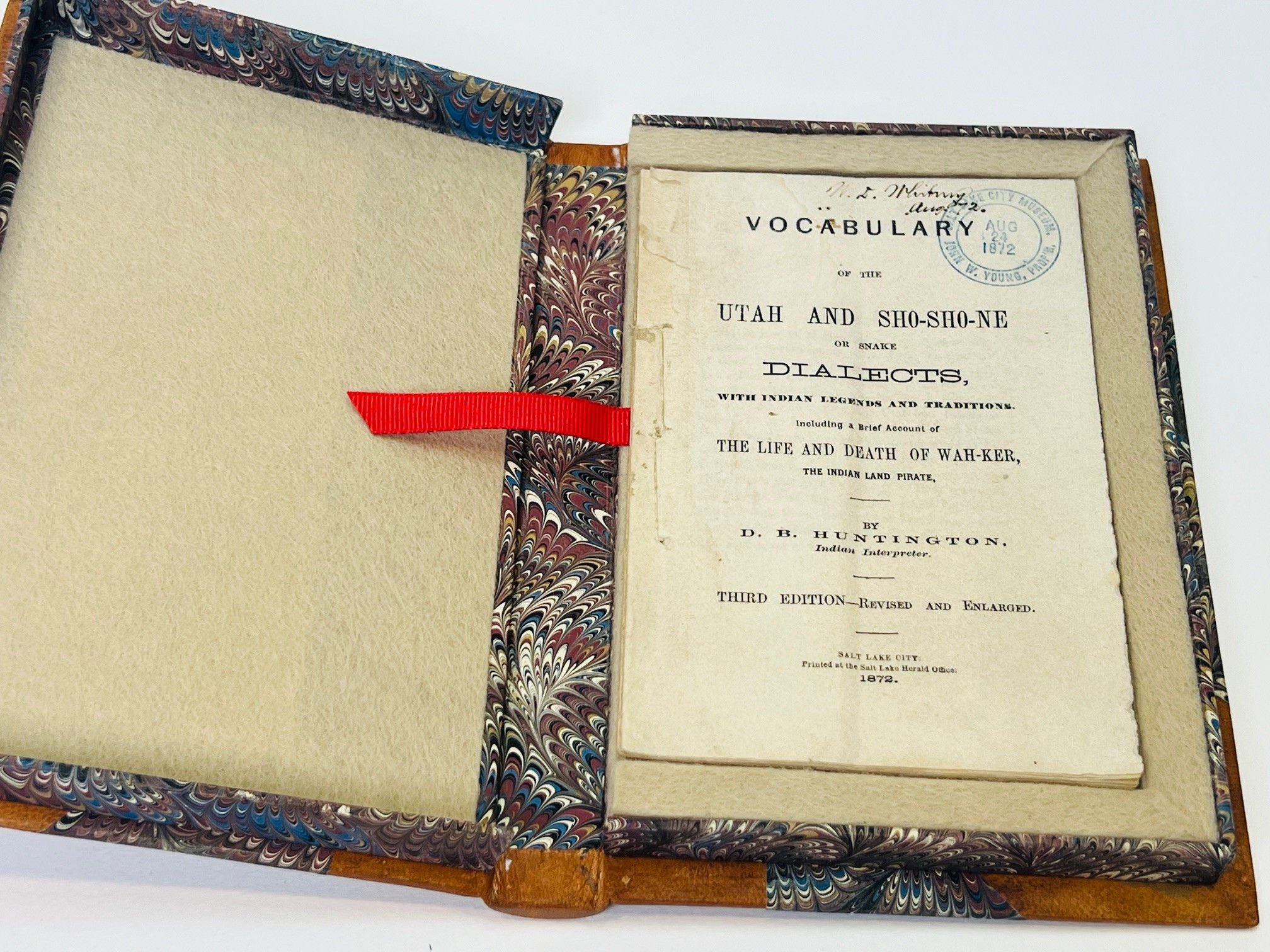VOCABULARY OF THE UTAH AND SHO-SHO-NE OR SNAKE DIALECTS, WITH INDIAN LEGENDS AND TRADITIONS. INCLUDING A BRIEF ACCOUNT OF THE LIFE AND DEATH OF WAH-KER, THE INDIAN LAND PIRATE. ... THIRD EDITION – REVISED AND ENLARGED.
Huntington, D.B.
Salt Lake City, 1872.
Salt Lake City, 1872. Pp. 32, stitched as issued, small bit of paper loss at blank inner margin of title professionally infilled,, else near fine in half polished calf and marbled board clamshell case. Signature of W.D. Whitney Aug '72 at top of title and stamp of John W. Young, Prop. Salt Lake City Museum Aug 24 1872. -- William Dwight Whitney was a famed American linguist at Yale, and John W. Young was son and Counselor of Brigham Young.
An LDS copy has the same Young stamp but dated August 10, 1872. Extremely rare. Only recently has a copy of the first edition (1853) of Dimick Baker Huntington's work been discovered in the LDS archives, while only two copies are known of the second (1854). This rare third contains a larger vocabulary, as well as the brief contemporary account of Wah-ker, a Shoshone who was baptized into the Church in 1850. Huntington, a prominent Mormon interpreter who spent a great deal of time with Wakara or Wah-ker, reports that, prior to the coming of the Mormons, the Ute had a vision of "the Lord sitting upon a throne dressed in white" and "that there would come to him a race of white people that would be his friends, and he must treat them kindly." Huntington, and likely Wah-ker himself, believed the Mormons fulfilled this vision. Wakara's War in 1853-4 became a defining event in the history of Mormon-Indian relations in Utah. Flake 4146.
The primary focus of the publication is to document and present vocabulary from the Utah and Shoshone (Snake) dialects. These are languages spoken by Native American tribes in the western United States. The work serves as a linguistic resource for those interested in studying and understanding the languages spoken by the Utah and Shoshone peoples during the 19th century.
In addition to the linguistic content, the publication includes Indian legends and traditions and provides cultural and historical context, offering insights into the traditions, stories, and way of life of these Native American groups.
The work is authored by D.B. Huntington. While the details about Huntington's background and expertise in linguistics are not provided in the information you provided, individuals involved in linguistic studies during the 19th century often had various interests, including anthropology and ethnography.
Wakara, also known as Wah-ker, was a prominent figure in the history of the American West during the mid-19th century. He was a Ute Indian chief and a leader of the Timpanogos Utes, a group that inhabited the region that is now Utah. Wakara was a respected and influential leader among the Ute people. His leadership became particularly significant during a time when interactions between Native American tribes and European settlers especially the Mormons, were becoming more complex.
Wakara played a notable role during the Utah War (1857–1858), a conflict between the U.S. government and the Mormon settlers in the Utah Territory. The U.S. government, concerned about the influence of the Mormon Church in the territory, sent troops to establish federal authority. Wakara and the Utes initially sided with the Mormons but later withdrew from the conflict, he eventually withdrew his support and adopted a neutral stance in the conflict.
It's important to note that historical perspectives on figures like Wakara may vary, and different sources may present different aspects of his life and actions.









